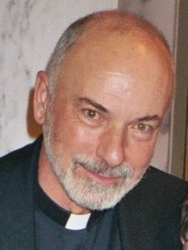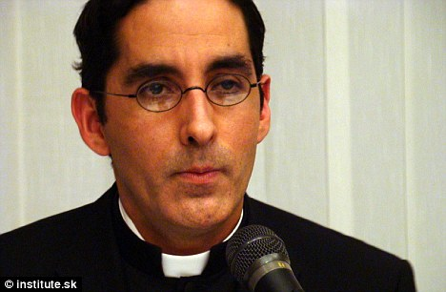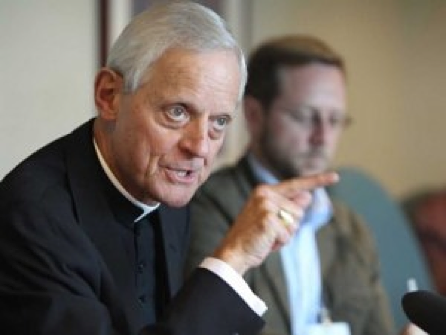The Expendables: Our Culture's War Against Catholic Priests
 Every year since 2002, the Catholic celebration of Holy Week has competed for space with a story of Catholic scandal in the secular news media.“If a house is divided against itself, that house will not stand.” (Mark 3:25)I hope I'm not the only one to notice the timing of some news accounts of scandal in the Catholic Church. For about a decade now, Holy Week and the weeks leading up to it have been the backdrop for embarrassing news stories about Catholic priests. Just after Holy Week two years ago, I wrote "Breaking News: I Got Stoned with the Pope!" My suggestive News of the World type headline was meant to get readers' attention with a hint of something sordid. I wanted to see if it works as well on Catholic blogs as it does in the supermarket tabloids.If you read that post, however, you know that the real sordid story was about the press itself, and not the Pope. He and I really did get stoned during Holy Week that year, but neither of us inhaled anything illegal.Then last year, CNN chose the middle of Holy Week to re-air some unproven scandal excavated from the Pope's own diocese in Germany from decades earlier. By emphasizing just the right elements of the story, while omitting several other factors, CNN slapped together a one-sided report apparently meant to unjustly slander both the Pope and the priesthood.In my post, "Cable News or Cable Nuisance?" I suggested that if there is to be any consistency at CNN, it will air its 9/11 special during Ramadan. Alas, that did not happen of course, but that's what first got the attention of Jamil Malik about whom I wrote recently in “Accommodations in the Garden of Good and Evil.” As Jamil pointed out in one comment, the news media could not treat the Muslim community as it does the Catholic community. Muslims would put their faith first, and would not tolerate it.FATHER JOHN CORAPI REVISITED
Every year since 2002, the Catholic celebration of Holy Week has competed for space with a story of Catholic scandal in the secular news media.“If a house is divided against itself, that house will not stand.” (Mark 3:25)I hope I'm not the only one to notice the timing of some news accounts of scandal in the Catholic Church. For about a decade now, Holy Week and the weeks leading up to it have been the backdrop for embarrassing news stories about Catholic priests. Just after Holy Week two years ago, I wrote "Breaking News: I Got Stoned with the Pope!" My suggestive News of the World type headline was meant to get readers' attention with a hint of something sordid. I wanted to see if it works as well on Catholic blogs as it does in the supermarket tabloids.If you read that post, however, you know that the real sordid story was about the press itself, and not the Pope. He and I really did get stoned during Holy Week that year, but neither of us inhaled anything illegal.Then last year, CNN chose the middle of Holy Week to re-air some unproven scandal excavated from the Pope's own diocese in Germany from decades earlier. By emphasizing just the right elements of the story, while omitting several other factors, CNN slapped together a one-sided report apparently meant to unjustly slander both the Pope and the priesthood.In my post, "Cable News or Cable Nuisance?" I suggested that if there is to be any consistency at CNN, it will air its 9/11 special during Ramadan. Alas, that did not happen of course, but that's what first got the attention of Jamil Malik about whom I wrote recently in “Accommodations in the Garden of Good and Evil.” As Jamil pointed out in one comment, the news media could not treat the Muslim community as it does the Catholic community. Muslims would put their faith first, and would not tolerate it.FATHER JOHN CORAPI REVISITED Closer to home, the story of Father John Corapi was also all the rage in the Catholic on-line world at this time last year. After hearing from many people asking me to comment on it, I wrote about it in "Good Bye, Good Priest! Father John Corapi's Kafkaesque Catch-22." Over at Scott Richert's Catholicism page on About.com, I too was dragged through the mud by a few hostile Catholics threatened by my alternate view of the story of priestly scandals in America.The point I tried to make in that controversial post was made against the tide of strong Catholic emotions on both sides of the Father John Corapi story.There were those who thought he was being railroaded and those who thought he ran and hid from both the priesthood and the truth. Many readers have asked me which of those versions I think is the truth, but I'm not going down that road. That is a matter between Father Corapi and the Church. The point I made has little to do with whether and how much he was really tainted by scandal. It was about whether any legitimate right of defense was ever afforded to him and whether the mere fact that he is a priest contributed to his undoing. When a priest is accused, he is instantly suspended, and unlike the plight of any other defendant in American justice, a priest is silenced by being unable to speak, write, or otherwise defend himself as a priest.I just read a terrific article by Catholic author, George Weigel, long associated with First Things magazine and a Senior Fellow at the Ethics and Public Policy Center. I have quoted George Weigel many times on These Stone Walls. The article I just came across is entitled "The Priest: Icon of Christ, Enabler of Sanctity." It was an address by George Weigel to the priests of the Diocese of Charleston, South Carolina on April 15, 2004. It's an article that I think every Catholic concerned for the priesthood should read. Every bishop and priest should read it twice. Consider these two excerpts which channel clearly the thoughts of George Weigel's very good friend - and mine - the late Father Richard John Neuhaus:
Closer to home, the story of Father John Corapi was also all the rage in the Catholic on-line world at this time last year. After hearing from many people asking me to comment on it, I wrote about it in "Good Bye, Good Priest! Father John Corapi's Kafkaesque Catch-22." Over at Scott Richert's Catholicism page on About.com, I too was dragged through the mud by a few hostile Catholics threatened by my alternate view of the story of priestly scandals in America.The point I tried to make in that controversial post was made against the tide of strong Catholic emotions on both sides of the Father John Corapi story.There were those who thought he was being railroaded and those who thought he ran and hid from both the priesthood and the truth. Many readers have asked me which of those versions I think is the truth, but I'm not going down that road. That is a matter between Father Corapi and the Church. The point I made has little to do with whether and how much he was really tainted by scandal. It was about whether any legitimate right of defense was ever afforded to him and whether the mere fact that he is a priest contributed to his undoing. When a priest is accused, he is instantly suspended, and unlike the plight of any other defendant in American justice, a priest is silenced by being unable to speak, write, or otherwise defend himself as a priest.I just read a terrific article by Catholic author, George Weigel, long associated with First Things magazine and a Senior Fellow at the Ethics and Public Policy Center. I have quoted George Weigel many times on These Stone Walls. The article I just came across is entitled "The Priest: Icon of Christ, Enabler of Sanctity." It was an address by George Weigel to the priests of the Diocese of Charleston, South Carolina on April 15, 2004. It's an article that I think every Catholic concerned for the priesthood should read. Every bishop and priest should read it twice. Consider these two excerpts which channel clearly the thoughts of George Weigel's very good friend - and mine - the late Father Richard John Neuhaus:
"If crisis-as-cataclysm is to become crisis-as-opportunity in the Catholic Church in America, then we must recognize that, at the bottom of the bottom line, today's crisis is a crisis of discipleship, a crisis of fidelity. And the only remedy for a crisis of fidelity is ... fidelity.""Sanctity is living in the truth about the human condition revealed by Christ. Living in that truth, we become the kind of people who can live with God forever. That is why the Holy Father, speaking to the cardinals of the United States just a year ago this week, said that today's crisis grew out of a failure to live and teach the fullness of Catholic truth. When we fail to teach the truth and live the truth - when we substitute what we imagine to be our truths for what Christ has revealed as the truth . . . we do not live as the saints we are called to be."
THE FATHER MARCEL GUARNIZO STORYThe truth is that the gates of hell cannot prevail against the Church whose origins I described in "Inherit the Wind: Pentecost and the Breath of God." However, as I pointed out in that Pentecost post last year, the Church was barely ten minutes old when scandal broke out. The Apostles, filled with the Holy Spirit, were accused by the crowd of being drunk at 9:00 in the morning on a day of ritual fasting. Saint Peter, the Church's first Bishop and Pope, stood before the crowd in a vigorous defense of his brothers, instructing the crowd that the scandal they have spread was entirely false (Acts 2:15).But alas, in the public relations debacles of the present, has the Sun set on the day when a priest facing injustice could look to his brother priests and bishop for a defense? On its surface, at least, the story of Father Marcel Guarnizo does not bode well for fundamental Catholic support of priests in the trenches of controversy.

Fr. Guarnizo has been vilified in the news media, and more recently was stripped of his faculties by the Archdiocese of Washington, after withholding Communion from a woman at a funeral Mass. According to Father Guarnizo's published statement, the woman came into the sacristy before Mass, introduced herself as a Buddhist, then introduced a woman accompanying her as her "lover." Father Guarnizo wrote that, like all priests, he presumes good faith when any person comes forward for the Eucharist, but this woman and her companion reportedly made a militant point of presenting themselves as living publicly a lifestyle that placed them in opposition to the Church.Note the word, "publicly." She made a point of divulging to Father Guarnizo before Mass the source and substance of her public separation from the Church. Then the woman went to a newspaper with her story of being denied the Eucharist by Father Guarnizo. Coming in the middle of Lent, it made just the sort of story the secular media loves to use to slam the Church.Eighteen years of wrongful imprisonment have made me naturally suspicious - though those who know me in prison tell me that I'm not nearly suspicious enough. Has it occurred to anyone else that Father Guarnizo was set up, that he was going to become a news story no matter what he did? The woman's revelations, it seems to me, could just as easily have resulted in a story about Father Guarnizo’s tacit approval of her issues and lifestyle had he accommodated her when she presented herself for Communion after making those flagrant revelations. The failure of the Archdiocese of Washington to defend Father Guarnizo in this is a far greater scandal for many.

This story has some painful echoes with one of my own. After priesthood ordination in 1982, I was assigned to a wonderful parish, Our Lady of the Miraculous Medal Parish in Hampton, New Hampshire. However, just months before I arrived there, officials of my diocese fired four nuns who had taught for a decade in the parish school. The dispute between the Diocese and the sisters had grown over time, and it was badly handled from every angle. After being told their contracts with the parish school would not be renewed, the sisters declined to leave quietly in the night. In successive public displays of dissent from the authority of the bishop, they filed a wrongful termination lawsuit in civil court, then went to the local and statewide secular press with their story.For a year, the sisters barricaded themselves in the parish convent while an organization of concerned parishioners and activists quickly grew in solidarity with them. The parish became divided with supporters of the Diocese on one side of the church at Mass, and supporters of the sisters wearing large “SOS" buttons ("Save Our Sisters") on the other. It was, to say the least, an unusual first assignment.The parish staff was solidly in the middle, stuck between a rock and a hard place. Sunday Masses in my first assignment as a priest were marked by the celebration of Mass inside the church, and a gauntlet of picket signs, reporters, and TV cameras outside. I've told this whole ugly story in a painful and rather tedious document posted on TSW entitled "Affidavit of Rev. Gordon J. MacRae."On Christmas Eve in 1982, the New Hampshire Supreme Court ruled that the sisters' religious ministry in the parish school did not terminate their contractual rights. The court defined their right to sue in a precedent setting case not unlike the one I described in "A Treacherous Descent: Religious Freedom is Put to the Test."By Holy Week of 1983, the lawsuit was nearing its court date. The other parish priest and I had nothing to do with the lawsuit. We simply sought to minister to the good people of this sadly divided parish without taking a side. By the very nature of our priesthood, however, we were seen by some activists as agents of the bishop, and subjected to constant negative attention, accusations, anonymous threats, and false witness, and even an occasional brick through the rectory window.Perhaps the most shameful form of that false witness came at Easter in 1983. A woman who had become part of the "Save Our Sisters" organization came to me in the sacristy before Mass and angrily accused me of siding with the Diocese and bishop in the dispute. I calmly reminded her that I had gone to great lengths to minister in this parish without becoming part of its divisions.The next day, the local newspaper carried a front page story reporting the woman's accusation that after her confrontation with me, I refused to give Communion to her two young daughters at Easter Mass. The little girls, the newspaper reported, went home in tears, devastated that I had denied them the Body of Christ. The parish anger seethed to a lynch mob frenzy after that story.There was just one problem with the story. It wasn't true. Nothing like that had ever occurred. But the most devastating part of the story for me was a statement from my Diocese that the reporter obtained without ever seeking a statement from me. A Diocesan spokesman, without even asking me if the story was true, presumed my guilt and capitulated to the mob, saying that I should never have done such a thing without first consulting with my Diocese.I was bruised and furious, of course. I waited a few days to calm down, then repeatedly called my bishop who was not in and never returned my calls. Then, when I was calm enough, I called the woman who was the source of the story. I asked her why she would say such a thing, but to my amazement, she apologized . . . well, sort of. She said, "I’m sorry, Father, but this is war, and sometimes in war one has to do and say certain things."In his great article, “The Priest: Icon of Christ, Enabler of Sanctity," George Weigel wrote that "Catholics today are capable of spiritual and moral grandeur." That is the truth. But some Catholics today are also capable of spiritual and moral grandiosity, treating their causes as superior to the truth. Just consider the tactics of SNAP. Consider the ways VOTF has used the priesthood scandals to further their goal of forming an American Catholic church. Consider the militancy of some gay activists who have used the Sacraments to mock the Church and demand sweeping changes in Catholic moral teaching to accommodate their cause.When I look at the story of what has befallen Father Marcel Guarnizo today, one Gospel passage comes immediately to mind: “I send you out as sheep in the midst of wolves.” (Matthew 10:16). George Weigel is right. Priests must be enablers of sanctity. But we must also be able to trust that our leaders will not be enablers of the wolves.